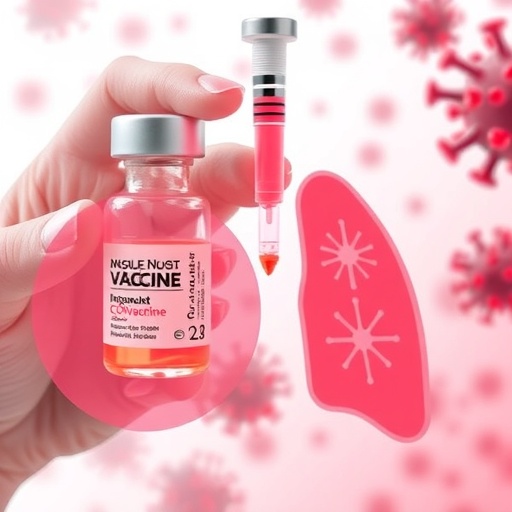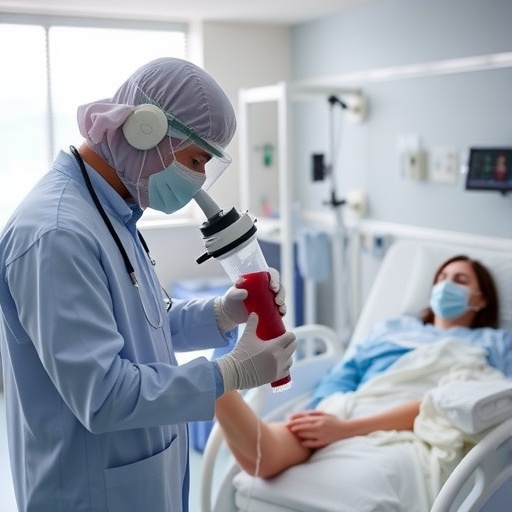
In a groundbreaking advancement in the fight against COVID-19, researchers have unveiled a next-generation inhaled aerosol vaccine designed to stimulate robust lung mucosal immunity. This innovative approach, detailed in a recently published phase 1 clinical trial, promises to reshape our understanding of respiratory vaccination and offers a beacon of hope in controlling current and future respiratory pandemics. Unlike conventional intramuscular vaccines, which primarily generate systemic immunity, this inhaled vaccine targets the mucosal linings of the respiratory tract — the very frontline of SARS-CoV-2 infection.
Respiratory viruses such as SARS-CoV-2 initiate infection by colonizing and replicating within the mucosal tissues of the upper and lower airways. Historically, vaccine strategies have focused on systemic immunity, primarily inducing circulating antibodies and T cells. However, such immunity may fall short in effectively intercepting pathogens at their portals of entry. The inhaled aerosol vaccine circumvents this limitation by directly delivering antigens to the respiratory mucosa, thereby provoking a localized mucosal immune response. This site-specific immunity plays a critical role in not only preventing viral entry and initial replication but also in forestalling transmission.
The phase 1 clinical trial in question was conducted as an open-label, multi-arm study involving healthy adult volunteers. Subjects received varying doses of the inhaled aerosol vaccine, with immunogenicity and safety as primary endpoints. Throughout the trial, extensive monitoring was performed to evaluate both systemic antibody responses and, importantly, mucosal immune factors, including secretory IgA and resident memory T cells in bronchoalveolar lavage samples and nasal swabs. The findings heralded a paradigm shift: robust mucosal antibody titers and memory T cell populations were elicited, landmarks that have evaded intramuscular COVID-19 vaccines to this date.
.adsslot_XKDzfVSm4u{width:728px !important;height:90px !important;}
@media(max-width:1199px){ .adsslot_XKDzfVSm4u{width:468px !important;height:60px !important;}
}
@media(max-width:767px){ .adsslot_XKDzfVSm4u{width:320px !important;height:50px !important;}
}
ADVERTISEMENT
At a molecular level, this novel vaccine uses a stabilized spike protein antigen formulated into microscopic aerosolized particles optimized for deep lung deposition. The particles were engineered to have aerodynamic diameters in the range of 1 to 5 micrometers, enabling their inhalation to reach both the upper bronchial regions and alveolar surfaces. Upon reaching the mucosal epithelium, the vaccine components prompt antigen-presenting cells including dendritic cells and alveolar macrophages to activate. These antigen-presenting cells then migrate to draining lymph nodes, orchestrating both localized and systemic adaptive immune responses.
The biological merit of targeting mucosal immunity lies in the specialized immunoglobulin A (IgA) antibodies predominating at these surfaces. Secretory IgA possesses unique properties—it can neutralize viruses extracellularly within mucosal fluids and, critically, inside epithelial cells during transcytosis, effectively arresting viral invasion at the point of contact. This contrasts with serum IgG antibodies that operate primarily in systemic circulation. The clinical trial results demonstrated a pronounced induction of mucosal IgA, a milestone suggesting the vaccine’s capacity to potentially curb viral acquisition and reduce transmission chains.
Safety observations from the trial were encouraging, with no severe adverse events recorded. Mild respiratory irritation was transient and resolved without intervention. The safety profile is especially noteworthy given the challenges that aerosolized vaccines pose, such as potential bronchoconstriction or inflammatory reactions. These findings open the door for broader application of aerosol vaccination strategies, not only against COVID-19 but potentially extending to other respiratory pathogens such as influenza and RSV.
Another pivotal insight was the induction of lung-resident memory T cells—effector immune cells that provide rapid localized responses upon re-exposure to the virus. Their presence in lung tissue is crucial for durable immunity, especially given that viral pathogens can evade systemic antibodies through rapid replication and mutation. Through bronchoalveolar lavage analyses, T cell populations exhibiting markers of residency and activation were significantly elevated post-vaccination, underscoring the vaccine’s effectiveness in establishing frontline cellular defenses.
The trial design employed multiple arms to compare different dosing regimens and scheduling, enabling the researchers to optimize immunogenic parameters. Secondary analyses also examined cross-reactivity potential against variants of concern, given the conserved nature of certain spike protein epitopes targeted by the vaccine. Preliminary data suggests broad neutralizing capacity, an attribute vital for combating emergent strains with spike mutations that may partially evade conventional vaccine-elicited antibodies.
In addition to molecular and cellular immunological assessments, the trial incorporated sophisticated systems immunology approaches. High-dimensional flow cytometry, transcriptional profiling, and multiplex cytokine assays provided comprehensive immunoprofiles. These methodologies unveiled mechanistic pathways underpinning the observed immune responses, highlighting the orchestration between innate immune sensors and adaptive effector mechanisms initiated by aerosol vaccination.
This next-generation inhaled vaccine platform distinguishes itself not only by immunological efficacy but also by the logistical advantages inherent in aerosol delivery. Needle-free administration reduces barriers related to vaccine hesitancy and needle-associated risks such as sharps injuries or infections. Furthermore, the capacity for self-administration or deployment in low-resource settings enhances equitable access—an underappreciated factor in global pandemic control.
Importantly, the successful induction of mucosal immunity offers a tactical advantage in potentially reducing viral shedding and onward transmission. While systemic immunity primarily mitigates disease severity, mucosal immunity can intercept pathogens before symptomatic infection manifests, thereby arresting community spread more effectively. This attribute could pivot public health strategies toward containment and suppression, especially in high-transmission scenarios and endemic circulation.
The implications transcend COVID-19 alone. As respiratory infections collectively account for significant morbidity and mortality worldwide, deploying aerosol vaccines tailored to stimulate mucosal immunity could revolutionize prophylactic interventions. This platform holds promise for adaptable formulations targeting diverse respiratory viruses and may integrate emerging adjuvants to further potentiate mucosal immune activation without compromising safety.
Looking ahead, ongoing phase 2 and phase 3 trials are poised to evaluate the durability of protection, real-world efficacy in diverse populations, and vaccination impact during outbreaks. Additionally, understanding the interplay between mucosal and systemic immunity, and defining correlates of protection specific to mucosal compartments, will be critical. Harnessing the mucosal immune system represents a frontier in vaccinology, with this trial laying the foundational proof-of-concept for aerosolized immunization against respiratory pathogens.
As the world continues grappling with the evolution of SARS-CoV-2 and the persistent threat of respiratory pandemics, innovative vaccination strategies like the inhaled aerosol vaccine are game-changers. By enhancing protection exactly where it is most needed—the lung mucosa—this approach promises not only to protect individuals but also to reshape community-level pandemic response and prevention paradigms.
In sum, the open-label, multi-arm phase 1 clinical trial validated the safety, immunogenicity, and biological rationale of a next-generation inhaled aerosol COVID-19 vaccine. By successfully inducing potent mucosal immunity alongside systemic responses, this platform heralds a new era of targeted respiratory immunization. Clinical translation efforts and further research will determine how broadly this strategy can be applied, but its transformative potential in infectious disease control is undeniable.
Subject of Research: Induction of lung mucosal immunity through inhaled aerosol vaccination against COVID-19.
Article Title: Induction of lung mucosal immunity by a next-generation inhaled aerosol COVID-19 vaccine: an open-label, multi-arm phase 1 clinical trial.
Article References:
Jeyanathan, M., Afkhami, S., D’Agostino, M.R. et al. Induction of lung mucosal immunity by a next-generation inhaled aerosol COVID-19 vaccine: an open-label, multi-arm phase 1 clinical trial. Nat Commun 16, 6000 (2025). https://doi.org/10.1038/s41467-025-60726-0
Image Credits: AI Generated
Tags: aerosol vaccine technologyCOVID-19 vaccine clinical trialinhaled COVID vaccinelocalized immune responselung mucosal immunitynext-generation vaccine developmentpandemic response strategiesrespiratory tract vaccinationrespiratory vaccination advancementsSARS-CoV-2 infection preventionsystemic vs mucosal immunityvaccine delivery methods





